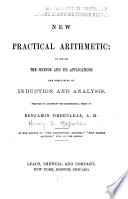 | Henry B. Maglathlin - 1894 - 370 pages
...the numerator or multiplying the denominator divides the fraction. 4. Multiplying or dividing both terms of a fraction by the same number does not change its value. >1 t-ll I ii I 1. If a unit be divided into 4 equal parts, what will be the name or denomination of... | |
 | Charles Edward White - Arithmetic - 1895 - 254 pages
...both terms of a fraction by the same number does not change its value. (Illustrate.) Dividing both terms of a fraction by the same number does not change its value. (Illustrate.) To reduce a fraction to higher terms, multiply both terms by the same number. Reduce... | |
 | Edward Brooks - Arithmetic - 1895 - 430 pages
...5x3 16 Hence WRITTEN EXERCISES. 1. How many fifteenths in 1 ? SOLUTION. — Since multiplying both terms of a fraction by the same number does not change its value (Prin. 1), we multiply both terms of ^ by the number which will give the required denominator, which... | |
 | George Washington Hull - Arithmetic - 1895 - 408 pages
...the terms of a fraction without changing its value ? 70. Principle. — Multiplying or dividing both terms of a fraction by the same number does not change its value. 5, How many thirds in | ? In T\ ? In 6. How many fifths in &? In •££? In WRITTEN EXERCISES. 7.... | |
 | Edward Brooks - Arithmetic - 1895 - 424 pages
...by the same number, and hence does not change its value. 6. Dividing both numerator and denominator of a fraction by the same number does not change its value. Since dividing the numerator divides the value of the fraction, and dividing the denominator multiplies... | |
 | Edwin Crawford Hewett - Arithmetic - 1896 - 312 pages
...when skillfully used. The object of the following lesson is to show that multiplying or dividing both terms of a fraction by the same number does not change its value. Lines are used for illustration. Have two lines of equal length on the board ; have one of them correctly... | |
 | Edwin Crawford Hewett - Arithmetic - 1899 - 280 pages
...when skillfully used. The object of the following lesson is to show that multiplying or dividing both terms of a fraction by the same number does not change its value. Lines are used for illustration. Have two lines of equal length on the board ; have one of them correctly... | |
 | Eugene L. Dubbs - Arithmetic - 1901 - 462 pages
...fraction to its lowest terms. REMARKS. 1. This operation depends upon the principle that dividing both terms of a fraction by the same number does not change its value. First Method (a) Reduce $ | to its lowest terms. EXPLANATION. Dividing both terms of ff by 7, the result... | |
 | William Estabrook Chancellor - Arithmetic - 1901 - 154 pages
...hundredths these fractions : 2' 1' 25' CT' I' A' 285' !!' MREDUCTION OF FRACTIONS Multiplying or dividing the terms of a fraction by the same number does not change the value of a fraction. $f = ? Dividing both terms by 2, we obtain f £. f of a dollar = 50 1. 1 of... | |
 | Michigan. Department of Public Instruction - Education - 1902 - 330 pages
...- 6; one of whose roots is 6 + | 6. AR1THMET1C. 1. Show that the division or multiplication of both terms of a fraction by the same number does not change its value. How is the value of a proper fraction affected by adding the same number to both of its terms? By subtracting... | |
| |